We’re taking a hands-on look at some of the best security cameras on the market to help readers make more informed choices about their security products.
Ring Stick Up Cam is a no-brainer for homeowners looking to flesh out their own de facto security system using the existing Ring arsenal, though it lacks some of the features of its competitors.
Main Features
- 1080p HD with night vision (infrared)
- 110° field of view
- Two-way audio
- IPX5 water-resistant for outdoor use
- Motion detection
- Person detection notifications
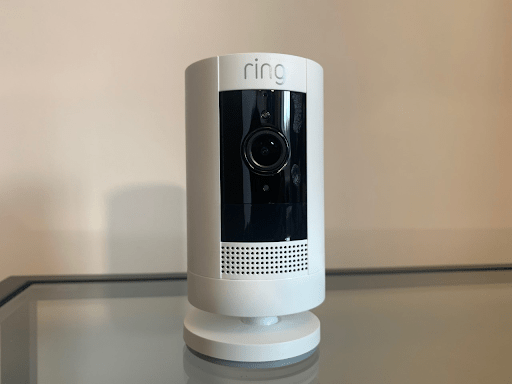
| Pros | Cons |
| ???? Attractive, sleek design ???? Clear, bright video quality ???? Easily create a fully-fledged security system using other Ring products ???? Automation is streamlined ???? Painless Amazon Alexa integration ???? Mounting plate attaches at two different points, making it versatile | ???? Battery takes ten hours to charge ???? The flat surfaces provide no cover the lens, meaning rain immediately blurs the image when used outside ???? No color night vision despite it appearing in the app’s settings ???? The best advanced features, including timelapses, require a subscription ???? Two-way audio, speaker, and siren are very quiet, sometimes inaudible when used outside |
Unboxing AlfredCam: Brilliant Security On A Budget
Packaging
Ring Stick Up Cam is packaged in a humbly-sized cardboard box that has absolutely zero plastic casing inside it, meaning the entirety of the packaging can be recycled.

The device itself was tucked up neatly, safely mitigating the risk of any damage being done to it while opening it up.

Inside is the camera, a micro USB charging cable, security screws, mounting screws, and anchors, a quick start guide, safety instructions guide, and warranty guide.
There’s also a rather generous selection of ‘attention’ stickers to warn folks that they’re being recorded (in six different languages, no less, so no excuses for not being aware of the recording).
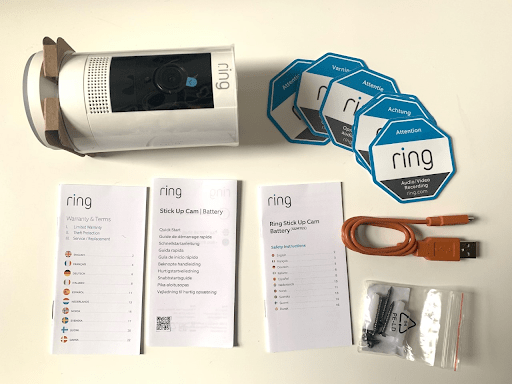
Installation & Onboarding
| App Setup Time | Mounting tools included? | Drilling? |
| 15 minutes | Screws x 6 Wall anchors x 3 Mounting base | ✅ |
After downloading the Ring app, a brief glimpse of the quick start guide revealed that the Ring Stick Up battery needs charging first. The mounting base must be twisted and pulled off to reveal the battery, which is then pulled out of the device to be charged using a micro USB cable.
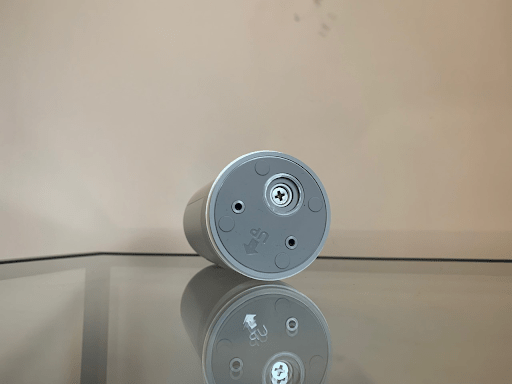
In total, about 10 hours passed between first plugging in the battery and the green light finally signaling that it was charged. Undoubtedly, this was by far the longest charging time I’ve experienced with an IP security camera thus far. Google Nest Cam was ready to use in less than half that time, while eufycam claims to be ready in 4-8 hours.
Setting up the device with the app was long-winded. There were some data sharing requests that couldn’t be skipped, including handing over a home address, which is displayed inside the app.


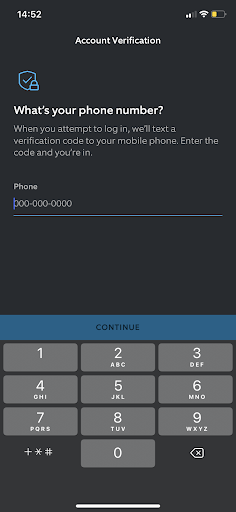
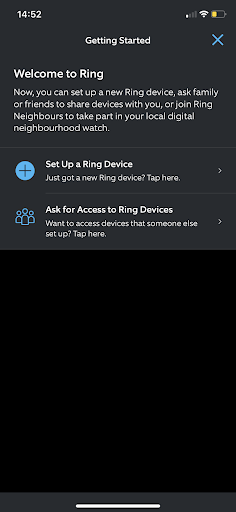
This may help to distinguish different Ring systems for people with multiple properties, or for the Ring Neighbors app, which shows a real-time crime map and safety alerts provided by neighbors and local authorities.
In a word, it’s going to be a full day between receiving the camera in the mail and actually using it, so be aware that a sizable part of the weekend needs to be set aside for charging, onboarding, and, if necessary, mounting the device.

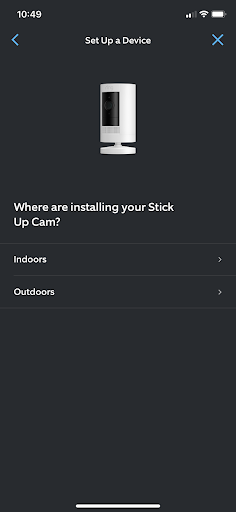
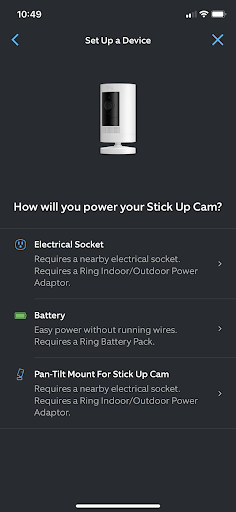

Many questions are asked about what the camera will be used for. The camera is paired to the viewing device by creating a Wi-Fi network that is connected to, and the QR code inside the unit is also scanned.
The app provides easy to follow instructions for mounting, which is appreciated, and since screws and anchors are included, all the user needs is a power drill/electric screwdriver.

The camera is paired via a QR code, which, unlike Nest Cam’s sticker, is stuck to the underside of the battery, so there’s no chance of accidentally throwing it away.
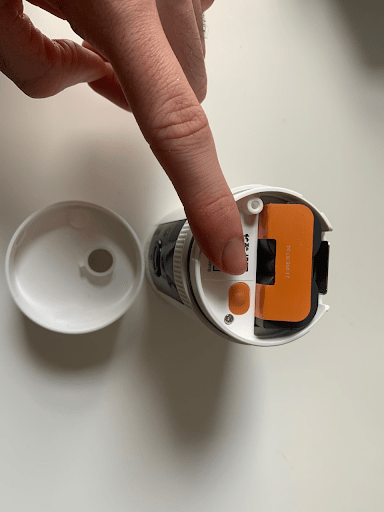
On the clock? AlfredCamera is ready to use in minutes.
Hardware – Durability, Aesthetics, Size, Weight
| Size | Weight | Weatherproof? | Casing | Tilt/Pan? | Local Storage? |
| 2.36 in x 2.36 in x 3.82 in without stand | 195.6 g | ✅ IPX5 | White matte plastic | ❎ | ❎ |
The Ring Stick Up Cam looks great. It’s slight and cylindrical, and the tough white matte plastic casing allows it to blend in quite seamlessly both inside and outside the home.

Soft plastic coverings hide two holes on the back used for wall mounting and for hardwiring, keeping it sleek from every angle. It’s thoughtfully designed and looks great on a mantelpiece.
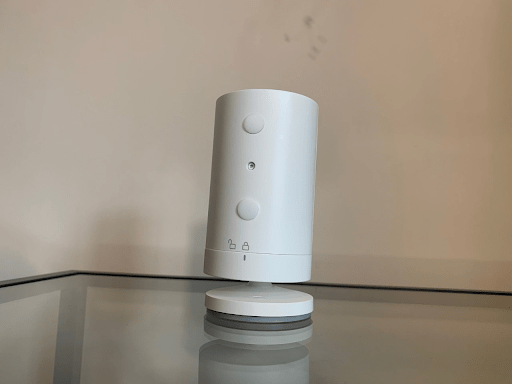
Weight-wise, it has a respectable heft to it caused by the large battery. Speaking of which, the battery is interchangeable across the Ring product line, which will be really handy for homes already decked out in Ring products (particularly if a battery goes missing).

The device is rated IPX5, which means it can resist a sustained, low-pressure water jet. In other words, it can be used in the rain without sustaining any damage.
As is the case with a lot of indoor-outdoor security cameras, there’s no visor or cover to protect the lens from water droplets like the kind that’s often seen on bullet cameras purpose-built for outdoor use. The device is flat, and the lens actually protrudes slightly from the body, meaning it gets covered in rain droplets.
While it’s not going to get damaged, the resultant image does get blurry pretty fast.
Nest Cam’s use of a magnetic mounting plate and its ball-like shape mean it can be tilted at a much wider degree of angles, including straight down from a high up location–effectively stopping the lens from being battered by vertical rain.
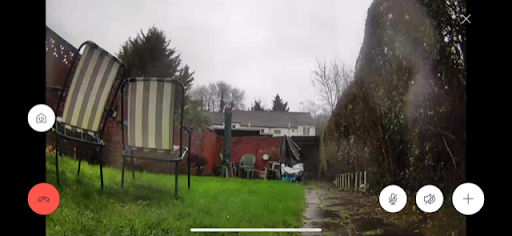
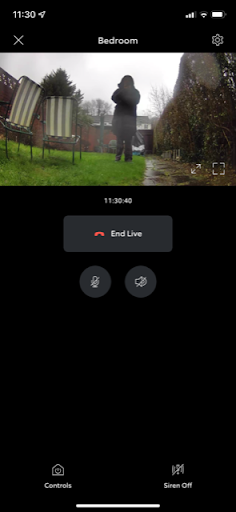
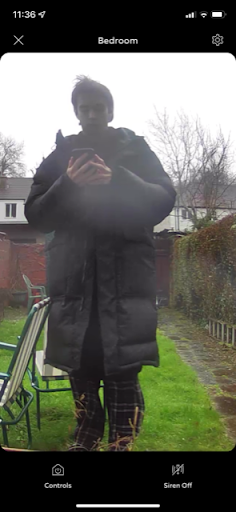
Outside footage. Raindrops blurred the lens quickly.
If rainfall is a concern, check out some of our tips on how you can better weatherproof your devices.
Astute security enthusiasts may notice the ‘X’ in the IP rating, which most likely means that this camera has not undergone dust-proof testing. It may or may not be susceptible to getting solids inside the unit, but I didn’t experience this.
Baffled by IP ratings? Get the lowdown on water and dust proofing here.
Battery life is good—it takes ten hours to charge, after all, so I wouldn’t have expected any less. It’s difficult to provide an accurate picture of how long it’ll last because it varies dramatically depending on how the camera is used.
Expect a few months of use if only using motion detection in limited traffic areas. Regular live stream use, on the other hand, will drain the battery much faster, but it should still last a month or so.
Software – App Usability, Third Party Compatibility
| Wi-Fi? | LTE Data (3G, 4G, 5G)? | Bluetooth? | Wired? |
| ✅ 2.4 GHz | ❎ | ❎ | ✅ ❎ Battery charges via USB cable, lasting several months with limited use. Option for hardwiring provided. |
With so many products under the brand’s belt, it’s not surprising that the Ring app works very well, is easy to navigate, and looks good. I experienced no crashes or bugs and found it intuitive enough to pick it up and know what to do straight away.
This is partly because automation is kept pretty simple and streamlined. Ring calls its automations ‘Modes’, which are accessed via the ‘Mode Settings’ menu. These are divided into three self-explanatory defaults—disarm, home, and away—which can be customized as the user sees fit.
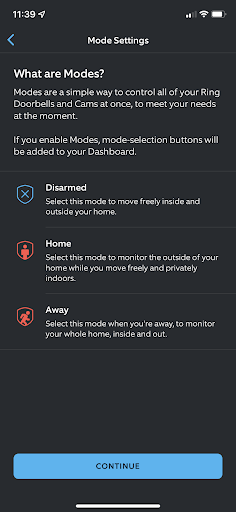
Particularly useful is Ring’s Geofence feature, which is a way to snooze and activate all Ring devices based on the user’s location.
Enabling Geofence creates a virtual perimeter around the property. When the device that the app is installed on is taken outside or inside that boundary, it can arm and disarm all Ring devices as required.
Geofence adds depth to Ring’s product line, making it easier to create a complete security system for a fraction of the price of services like ADT.

Ring Stick Up Cam’s live camera feed struggled to maintain fluid and stable footage when multiple people were using the Wi-Fi, and the camera needed to be close to the router for it to work well. A Wi-Fi extender was insufficient in stabilizing the connection when the Cam was far from the router.
Ring pairs perfectly with Alexa, making it easier to control both the camera and any peripheral products with simple voice commands. Some models are sold with an Echo Dot speaker. Google Assistant can pair as well, but there is no live streaming through screen-based Google Home products.

Compared with the more complex automations that can be done on Wyze, Google Home, and Kasa Smart, there isn’t a learning curve to figuring out what to do on the Ring app.
When enabled, modes are displayed clearly at the top of the home of the main tab, making them easy to switch between manually if users aren’t so hot on the idea of Geofence.
AlfredCamera easily maintains a stable live feed connection. Discover how AlfredCam is easily integrated.
Camera
| Quality | Frame rate | Field of view | Infrared |
| 1080p HD | 15 FPS | 110° | ✅ |
Ring Stick Up Cam produces clear, high quality footage in 1080p HD. Colors pop and are well-balanced.
The 110-degree field of view may sound somewhat underwhelming given that this is far from the cheapest budget IP camera on the market, but the images produced are surprisingly curved, capturing quite large spaces with ease.
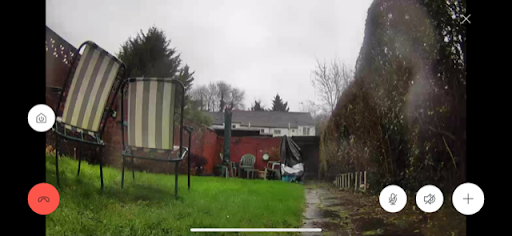

Oddly, neither the quality nor the framerate can be changed. Comparatively, AlfredCamera has three quality modes that the user can choose from, which helps optimize performance irrespective of internet connection strength.
Reolink also has impressively detailed quality settings on its devices, useful for those that like to tailor their experience with total precision.
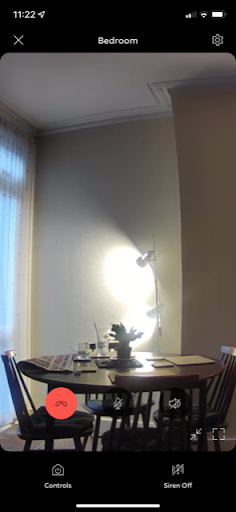

Digital zoom works quite well, though loss of quality is to be expected.
Features that can be changed include recording time, which can be set to somewhere between 15 and 120 seconds. If Advanced Motion Detection is enabled, recording length will be determined case-by-case.
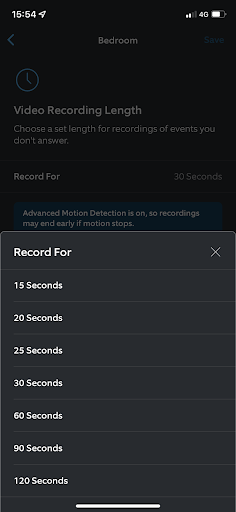
For a 1080p camera, the Stick Up Cam doesn’t exactly go easy on the Wi-Fi, so it would have been nice to have more flexibility in quality settings.
Speaking of which, the live feed was temperamental. Freeing up the router certainly helped, but the camera would be best left to its own devices (i.e. motion detection-based use).
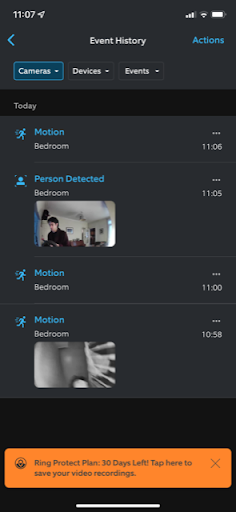
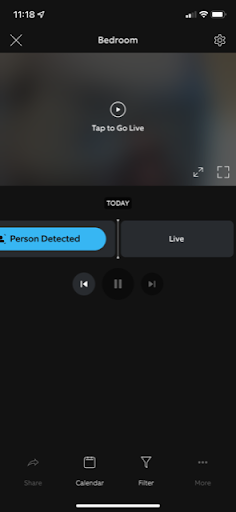
Motion detection event history works well.
Not to mention, I noticed using the live feed drained the battery quickly. Perhaps that’s why there is an option to relinquish access to the live feed in the settings.
Person detection can be enabled or disabled, and the app notifies the user that this makes notifications somewhat slower, which I found to be true. Close to the router, they generally arrived within 2-3 seconds of motion being detected.



Night vision is good. When automatic night vision is enabled, the camera opts for activating it in lower light even when it isn’t completely dark, which helps improve visibility. Although it can be enabled in the settings, there is actually no color night vision feature on the battery-powered Ring Stick Up Cam.

With up to 1080p HD live viewing, AlfredCam provides great indoor surveillance. Learn more about AlfredCam’s technical specs.
Audio
| Microphone | Speaker | Siren |
| ✅ | ✅ | ✅ |
Compared with all other IP security cameras I’ve used, the speaker on the Ring Stick Up Cam was noticeably quiet. Much like the camera quality, there’s no option to change the volume, meaning two-way audio and the siren are both affected.
If the camera’s being used inside, the audio levels will be sufficient for casual surveillance in most homes.
Even with an average level of outside ambient noise, two-way talk is almost inaudible through the camera’s speaker, and the siren can’t exactly be described as the most threatening of warnings.
It’s easy to imagine that congested urban areas will drown out the audio significantly, particularly if using the camera on a porch as an alternative to a doorbell camera.
Alfred hears you loud and clear thanks to excellent two-way audio. Discover the different ways you can use AlfredCam’s two-way audio function.
Cost
| Ring Stick Up Cam (Battery) Model | Subscription Service |
| RRP $99.99 | From $3 a month |
The Ring Stick Up Cam (battery) retails at $99.99, though it can be frequently found on sale or in package deals. The price-point seems a fair middle-ground between budget friendly indoor IP cameras and more advanced outdoor ones.
Subscriptions are varied. The Protect Basic Plan starts at $3.99 a month to cover a single device, while the most expensive option, Protect Pro, is $20 a month. Users that own other Ring products, naturally, will want the Protect Pro plan, since it will cover everything. It’s also available for $200 a year.
Prioritizing budget? Alfred Premium costs just $29.99 a year, while AlfredCam is available now for the same price.
Recommended reading:
Wyze Cam V3
Kasa Spot Pan Tilt (EC70)
Reolink E1 Pro 2K Panning Security Camera
Wyze Cam Pan V2
Google Nest Cam (Battery)
Blink Mini
